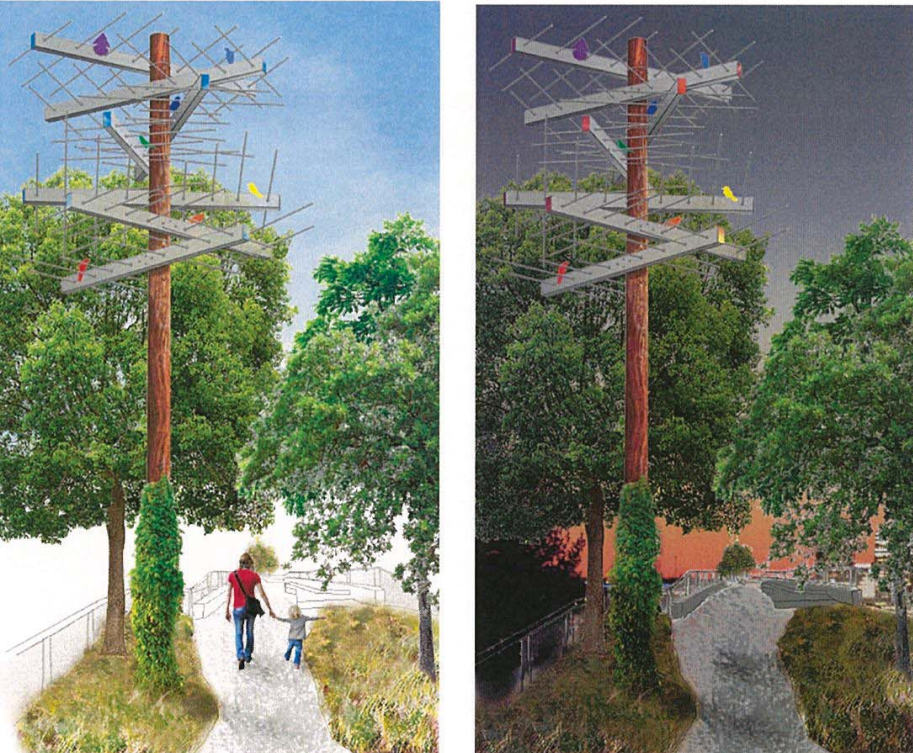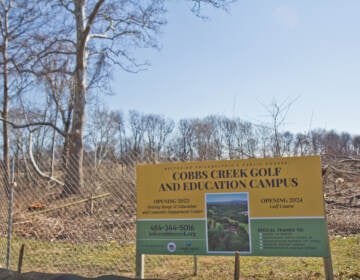Utility pole public art for Rail Park gets conceptual approval

Municipal meetings that feature poetry readings are rare, even at the Philadelphia Art Commission. But on Wednesday morning, at an unveiling of the percent for art installation proposed for the Rail Park, the room received several snippets of poetry by Audre Lorde and Pablo Neruda.
The poet Laynie Browne wanted to give the assembled commissioners an idea of the types of poems she is considering for the walkway, which will be studded with grey bricks inscribed with black granite text bearing verse meant to evoke a wilderness in the city.
This winding pathway will lead up to a 35-foot mockup of a telephone pole, featuring multi-colored bird silhouettes that grasp onto the facsimile of telephone wires.
The installation is the work of Brent Wahl, who is working with Browne on the project. (They have collaborated before, as his artwork graces the cover of her most recent poetry collection.)
Wahl told the Art Commission that the piece is meant to be evocative of communication and the city as a meeting place of cultures. He noted that telephone lines often ran along rail lines and that photos of historical Philadelphia gave him the inspiration for the idea.
“We started to think at what marks this space as unique and we realized that inevitably it was about the structures lurking above,” said Wahl. “Why do these structures lure people in? Not only do these have that industrial age beauty but they ground us and refer to the past.”
Wahl said that the telephone poles could blend in with the natural environment as well, standing as tall as trees and attracting the attentions of plant and animal life that climb up it or perch upon it. Wahl said he expected the installation to “nestle” into the surrounding trees. He hoped that vines would grow up its base, further camouflaging it. The renderings included aspirational ivy doing just that.
The colored birds would perch upon seven cross arms, pointing in the directions of a compass’ cardinal and intermediate points. The birds will be made of powder-coated aluminum. They would be yellow, red, orange, green, blue, indigo, and violet— “representing the diverse population of our city,” said Wahl.
The poetry embedded in the path leading up to this installation would be written in the poets’ original languages. Neruda’s lime, for example, would be in Spanish. While those of a poet like Harriet Mullin, of Los Angeles, would be in English. The selections seemed to evoke a wonder in both nature and the city.
“Gazing up at the city’s hanging gardens, concrete walls and freeway overpasses and overgrown fringes of tangled vines,” intoned Browne, reading from Mullins’ recent book “Urban Tumbleweed”.
At first the Art Commission seemed skeptical, more of the offered renderings than of the actual proposal. Robert Roesch fretted that the birds would be too small and that the public wouldn’t be able to see them atop the 35-foot structure, with a 34-inch circumference. But Wahl assured him they would be 14 inches long, larger than a pigeon.
“They’ll be fairly large but I want them to look like birds, not like hulking vultures up there,” said Wahl.
Roesch offered the harshest criticism, initially recommending that the two artists be made to retune with new renderings or even a model to depict their intention more clearly.
“I feel that right now, the way we are looking at it, it’s chaotic and it doesn’t have a sense of place,” said Roesch. “Larger birds, many more birds, something to complicate the design because right now the music is without melody.”
“If it’s going to be an icon you can see from the street you don’t want to look at it and see a confluence of chaos it’s got to have something we can read right away.
But Browne defended her embattled partner’s effort and showed the commissioners examples of his previous artwork, which she described as “elegant in execution.”
This mollified the commissioners, who offered some light criticism of her plans for the poetry in many languages. Blocks in Spanish and English could be read by many residents of the city, as those are the two most common languages, but lines in German or Russian would be less accessible. The commission also recommended Chinese poets, due to the site’s proximity to Chinatown (that language is also the third most commonly spoken in Philadelphia).
In the end, the Art Commission moved for conceptual approval of the installation.
WHYY is your source for fact-based, in-depth journalism and information. As a nonprofit organization, we rely on financial support from readers like you. Please give today.






